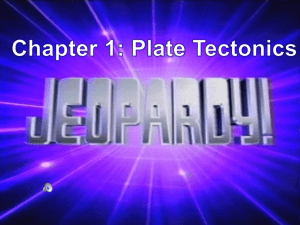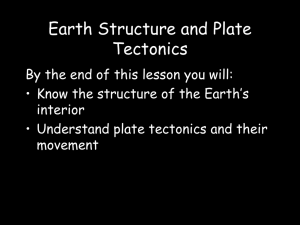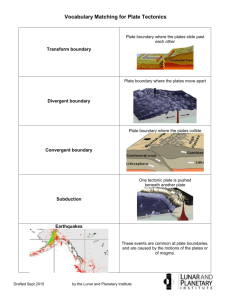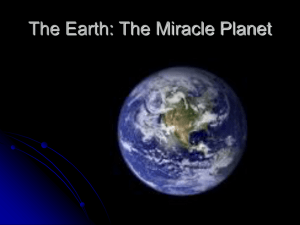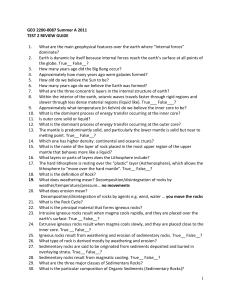Plate Tectonics Test Review
advertisement
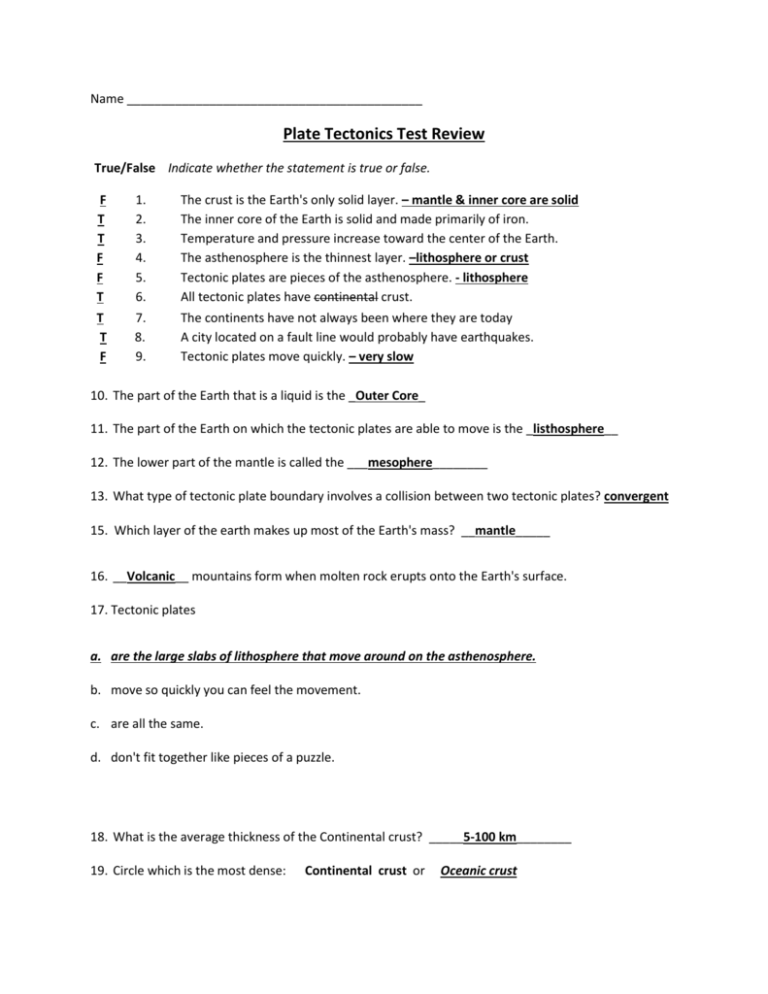
Name ___________________________________________ Plate Tectonics Test Review True/False Indicate whether the statement is true or false. F T T F F T 1. 2. 3. 4. 5. 6. The crust is the Earth's only solid layer. – mantle & inner core are solid The inner core of the Earth is solid and made primarily of iron. Temperature and pressure increase toward the center of the Earth. The asthenosphere is the thinnest layer. –lithosphere or crust Tectonic plates are pieces of the asthenosphere. - lithosphere All tectonic plates have continental crust. T T F 7. 8. 9. The continents have not always been where they are today A city located on a fault line would probably have earthquakes. Tectonic plates move quickly. – very slow 10. The part of the Earth that is a liquid is the _Outer Core_ 11. The part of the Earth on which the tectonic plates are able to move is the _listhosphere__ 12. The lower part of the mantle is called the ___mesophere________ 13. What type of tectonic plate boundary involves a collision between two tectonic plates? convergent 15. Which layer of the earth makes up most of the Earth's mass? __mantle_____ 16. __Volcanic__ mountains form when molten rock erupts onto the Earth's surface. 17. Tectonic plates a. are the large slabs of lithosphere that move around on the asthenosphere. b. move so quickly you can feel the movement. c. are all the same. d. don't fit together like pieces of a puzzle. 18. What is the average thickness of the Continental crust? _____5-100 km________ 19. Circle which is the most dense: Continental crust or Oceanic crust 20. Scientists believe that the Earth's core is made mostly of what material? ___iron_____ 21. The strong, lower part of the mantle that lies beneath the asthenosphere is called the __mesophere__ 22. The soft layer of the mantle on which pieces of the lithosphere move is called the ___asthenophere_ 23. The solid, dense center of our planet is called the __inner core____ 24. The liquid layer that lies beneath the mantle and surrounds the inner core is called the __outer core____ 25. The __asthenosphere________ is made of solid rock that flows very slowly 26. The ____crust____ is divided into tectonic plates 27. Which of the following is NOT a major tectonic plate? a. Caribbean plate c. Eurasian plate b. Antarctic plate d. North American plate 28. The North American plate consists a. entirely of oceanic crust. c. of both continental and oceanic crust. b. entirely of continental crust. d. None of the above Examine the diagram below, and answer the questions that follow. 29. In the diagram above, which of the following has formed at B? a. a folded mountain c. a volcanic mountain b. a fault-block mountain d. none of the above 30. Which layer of Earth is thickest? __mantle___ 31. Where do most major mountain ridges form? __continental plates collide______ 32.-37. Label the major the major plates below using the word bank provided: 1. North American -A 2. African Plate -D 3. Pacific Plate-B 4. Antarctic Plate -F 5. South American-E 6. Indo-Australian Plate -G 7. Eurasian Plate -C 38. What is uplift? Give an example. _places where crust is higher______________ ________________________________________________________________________________________ 39. What is compression? Give an example. ____squeezing or 2 plates colliding Ex. Folded mountains; Himalayas___________________________________________________________________________ 40. When a dense oceanic plate collides with a less dense continental plate what happens? ________________ ___the oceanic plate is subducted below the continental plate; also get a TRENCH___________________ 41. San Bernardino is a fault line in CA. What natural disaster occurs there frequently? ___earthquakes_____ 42. What is plasticity? ____being able to be molded or altered; Asthenophere is the solid layer with plasticity in the upper mantle that is located just below the lithosphere_____________________ 43. What will occur? Mountain; converge Earthquake; transform





